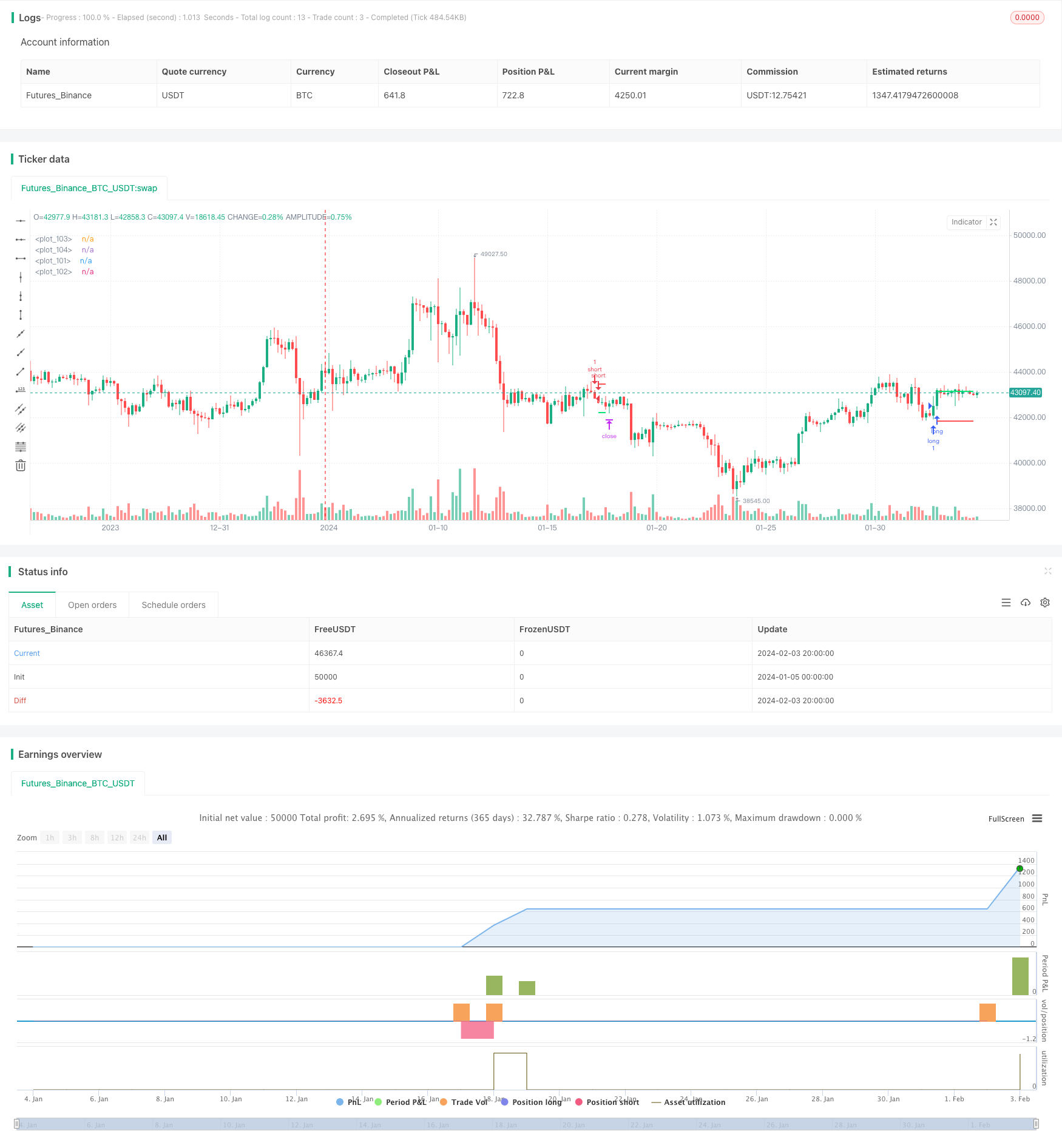
概述
本策略融合了Ichimoku云图、移动平均线、MACD、Stochastic和ATR等多个指标,实现多时间框架下的趋势识别和跟踪。在获得较高概率的趋势信号后,采用ATR周期止损止盈方式进行风险控制。
策略原理
Ichimoku云图判断中长线趋势方向。CLOSE价格上穿云图的转折线和基准线为多头信号,下穿为空头信号。
MACD判断短线趋势和超买超卖情况。MACD柱线上穿信号线为多头信号,下穿为空头信号。
Stochastic KD判断超买超卖区。K线上穿20为多头信号,下穿80为空头信号。
移动平均线判断中期趋势。收盘价上穿移动平均线为多头信号,下穿为空头信号。
综合以上多个指标信号,过滤掉部分假信号,形成高概率的持续性趋势信号。
基于ATR计算止损止盈价格。以一定的ATR倍数作为止损位和止盈位,实现风险控制。
策略优势
多时间框架识别趋势,提高信号准确率。
广泛运用指标组合过滤技术,有效过滤假信号。
ATR周期性止损止盈,最大程度控制单笔损失。
可自定义入场条件严格程度,满足不同风险偏好。
策略风险
以趋势跟踪为主,无法识别突发事件带来的逆转。
ATR周期性止损可能过于理想化,实盘中难以完全复制。
参数设置不当可能导致交易频率过高或信号识别准确率不足。
需要调整参数找到平衡,适应不同品种和市场环境。
策略优化方向
增加机器学习算法,辅助判断趋势转折点。
优化ATR倍数参数,不同品种可以设置不同倍数。
结合交易量变化等其他因素,提高突破信号的准确率。
根据回测结果不断优化参数,找到最佳参数组合。
总结
本策略综合运用Ichimoku云图、MACD、Stochastic等多个指标进行多时间框架的趋势识别,在抓住趋势的同时尽量避免被突发事件套牢。ATR周期性止损止盈方式有效控制单笔亏损,是一种值得推荐的趋势跟踪策略。通过引入更多辅助判断指标和机器学习方法,本策略还有进一步优化的空间。
/*backtest
start: 2024-01-05 00:00:00
end: 2024-02-04 00:00:00
period: 4h
basePeriod: 15m
exchanges: [{"eid":"Futures_Binance","currency":"BTC_USDT"}]
*/
// This source code is subject to the terms of the Mozilla Public License 2.0 at https://mozilla.org/MPL/2.0/
// © FXFUNDINGMATE
//@version=4
strategy(title="FXFUNDINGMATE TREND INDICATOR", overlay=true)
//Ichimoku Cloud
conversionPeriods = input(9, minval=1, title="Conversion Line Length")
basePeriods = input(26, minval=1, title="Base Line Length")
laggingSpan2Periods = input(52, minval=1, title="Lagging Span 2 Length")
displacement = input(26, minval=1, title="Displacement")
donchian(len) => avg(lowest(len), highest(len))
conversionLine = donchian(conversionPeriods)
baseLine = donchian(basePeriods)
leadLine1 = avg(conversionLine, baseLine)[displacement - 1]
leadLine2 = donchian(laggingSpan2Periods)[displacement - 1]
//macd
fast_length = input(title="Fast Length", type=input.integer, defval=12)
slow_length = input(title="Slow Length", type=input.integer, defval=26)
src = input(title="Source", type=input.source, defval=close)
signal_length = input(title="Signal Smoothing", type=input.integer, minval = 1, maxval = 50, defval = 9)
sma_source = input(title="Simple MA (Oscillator)", type=input.bool, defval=false)
sma_signal = input(title="Simple MA (Signal Line)", type=input.bool, defval=false)
fast_ma = sma_source ? sma(src, fast_length) : ema(src, fast_length)
slow_ma = sma_source ? sma(src, slow_length) : ema(src, slow_length)
macd = fast_ma - slow_ma
signal = sma_signal ? sma(macd, signal_length) : ema(macd, signal_length)
hist = macd - signal
//kd
periodK = input(5, title="%K Length", minval=1)
smoothK = input(3, title="%K Smoothing", minval=1)
periodD = input(3, title="%D Smoothing", minval=1)
k = sma(stoch(close, high, low, periodK), smoothK)
d = sma(k, periodD)
//atr
atrlength = input(title="Atr Length", defval=8, minval=1)
SMulti = input(title="Stop loss multi Atr", defval=1.0)
TMulti = input(title="Take profit multi Atr", defval=1.0)
smoothing = input(title="Smoothing", defval="RMA", options=["RMA", "SMA", "EMA", "WMA"])
ma_function(source, length) =>
if smoothing == "RMA"
rma(source, length)
else
if smoothing == "SMA"
sma(source, length)
else
if smoothing == "EMA"
ema(source, length)
else
wma(source, length)
atr = ma_function(tr(true), atrlength)
operation_type = input(defval = "Both", title = "Position side", options = ["Long", "Short", "Both"])
operation = operation_type == "Long" ? 1 : operation_type == "Short" ? 2 : 3
showlines = input(true, title="Show sl&tp lines")
// MA
sma_len = input(100, title="MA Length", type=input.integer)
sma = sma(close, sma_len)
longCond = crossover(k, 20) and macd > 0 and close > sma and close > leadLine1 and close > leadLine2
shortCond = crossunder(k, 80) and macd < 0 and close < sma and close < leadLine1 and close < leadLine2
entry_price = float(0.0) //set float
entry_price := strategy.position_size != 0 or longCond or shortCond ? strategy.position_avg_price : entry_price[1]
entry_atr = valuewhen(longCond or shortCond, atr,0)
short_stop_level = float(0.0) //set float
short_profit_level = float(0.0) //set float
long_stop_level = float(0.0) //set float
long_profit_level = float(0.0) //set float
short_stop_level := entry_price + SMulti * entry_atr
short_profit_level := entry_price - TMulti * entry_atr
long_stop_level := entry_price - SMulti * entry_atr
long_profit_level := entry_price + TMulti * entry_atr
// Strategy Backtest Limiting Algorithm
i_startTime = input(defval = timestamp("1 Jan 2020 00:00 +0000"), title = "Backtesting Start Time", type = input.time)
i_endTime = input(defval = timestamp("31 Dec 2025 23:59 +0000"), title = "Backtesting End Time", type = input.time)
timeCond = true
if (operation == 1 or operation == 3)
strategy.entry("long" , strategy.long , when=longCond and timeCond, alert_message = "Long")
strategy.exit("SL/TP", from_entry = "long" , limit = long_profit_level , stop = long_stop_level , alert_message = "Long exit")
if (operation == 2 or operation == 3)
strategy.entry("short", strategy.short, when=shortCond and timeCond, alert_message="Short")
strategy.exit("SL/TP", from_entry = "short", limit = short_profit_level , stop = short_stop_level , alert_message = "Short exit")
if time > i_endTime
strategy.close_all(comment = "close all", alert_message = "close all")
plot(showlines and strategy.position_size <= 0 ? na : long_stop_level, color=color.red, style=plot.style_linebr, linewidth = 2)
plot(showlines and strategy.position_size <= 0 ? na : long_profit_level, color=color.lime, style=plot.style_linebr, linewidth = 2)
plot(showlines and strategy.position_size >= 0 ? na : short_stop_level, color=color.red, style=plot.style_linebr, linewidth = 2)
plot(showlines and strategy.position_size >= 0 ? na : short_profit_level, color=color.lime, style=plot.style_linebr, linewidth = 2)
//}